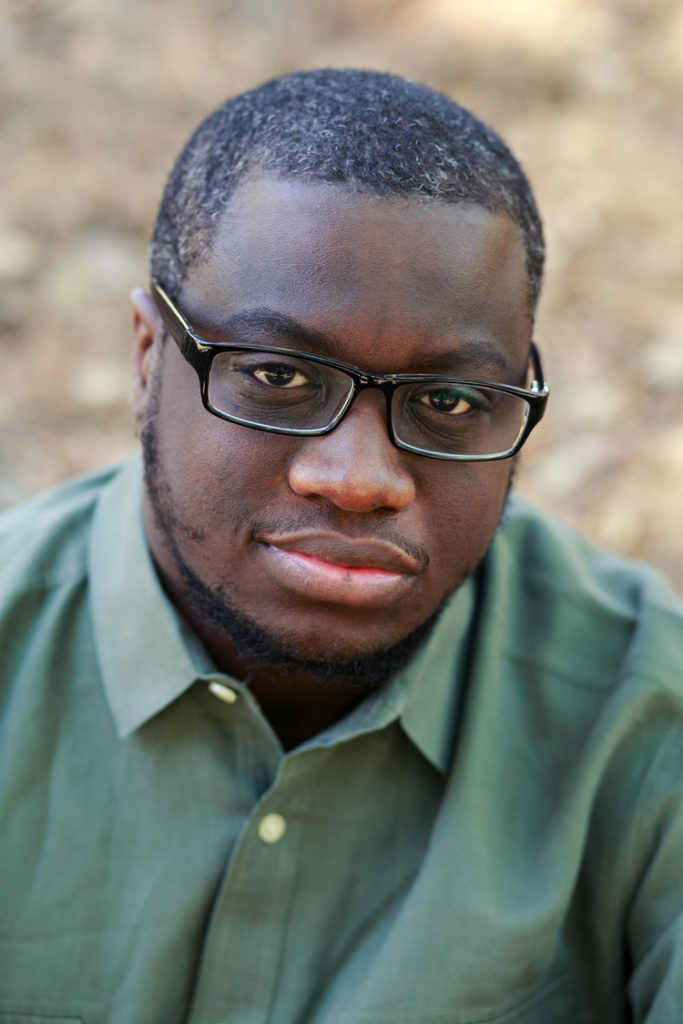
First things first: Rion Amilcar Scott’s collection The World Doesn’t Require You is one of 2019’s very best books. It contains an array of stories that run the gamut from academic satire to subtle reckonings with history and folklore. Want boldly conceptual speculative narratives? You’ll find those in there, too. And the thing is, it all comes together brilliantly. Needless to say, I had a couple of questions for him on how this book came together; and lo, he answered them.
I’d say that your prose has a scriptural or liturgical feel to it at times, even when you’re not directly addressing questions of religion and belief. How would you describe the relationship between your prose and the sacred?
There are times I’m stuck when I’ll go back and read parts of the King James Bible for its poetry, particularly the Book of Revelation, so that’s part of my DNA. Storytelling and art should feel sacred. My conception of Cross River, MD, my fictional town, is a bunch of people either confronting or turning their backs on their sacred power.
The stories in The World Doesn’t Require You contain some references to the work of other contemporary writers — I’m thinking in particular of Kate Zambreno and Helena Fitzgerald. What prompted you to blend the real and the fictional in this way? And have you gotten any response from the writers who’ve found themselves in your stories?
The references to the work of contemporaries occurs in a student’s imagined research paper and a professor’s imagined syllabus. When I was creating these documents, I was sort of pretending I was this student and this professor and I researched these topics just as they would. And then I put made up works next to real works partly because it seemed like the text needed works that are too specific-to-my-world or too crazy to really exist, and partly because it’s amusing to me to hear about people looking for the fictional books. It was fun to read or re-read the real works in this context. The Kate Zambreno book, Heroines, is one I’ve always wanted to read because I enjoy her work, so I guess I willed it off my TBR pile. I’ve heard nothing from the authors mentioned. I hope they find it funny being cast in my book this way.
A number of the stories in your collection deal with rituals and ceremonies — perhaps most ominously in “A Loudness of Screechers.” Elsewhere, you also use academic life as a setting, which has its share of rituals as well. What prompted the juxtaposition of these two worlds?
It seems to me that we are highly ritualized to our detriment at times. At times we follow rituals without thinking through what they mean, if they still have relevance. Academia makes a claim to intellectualism as a way to transcend so many of our foibles, but academia can be as rote and unthinking as any other realm of life. The gap between perception and reality creates a really delicious tension. There is a layer of pomposity there that I couldn’t help but make light of.
When you’re working on stories, such as these, that aren’t strictly realistic in tone, how much do you know going in about the groundrules of the story’s setting?
I’m pretty much making up the groundrules of any story as I go along, at least in the initial draft. Even though most of my stories take place in the same town, I have to make the town anew, to sell it anew with each story. That’s the case even if characters or elements return from previous works. The groundrules come about from character interactions, with each other and the setting, as well as the needs of the plot.
Your collection closes with the novella “Special Topics in Loneliness Studies.” Did you ever think about publishing this as a standalone work?
I did toy with publishing the novella on its own, but it felt so tied to other stories in the book, particularly “Numbers,” which it is somewhat a rebuttal to. It certainly could stand on its own, but I think it grows in power in close proximity to the other works it is in conversation with. Those other works become stronger too, in retrospect, once they have “Special Topics” to argue with.
The World Doesn’t Require You isn’t quite bookended with stories dealing with academia, but it comes close to it. What inspired that, structurally speaking?
I didn’t consciously think about bookending (or nearly bookending) the collection with stories about academia. I intended to place “Special Topics” in the middle of the book, but it grew too long in the drafting to be anywhere but the end. “Nigger Knockers” is up near the front because after the first story, “David Sherman,” it was the most disorienting.
How long did it take for you to get these stories into an order that felt right?
I don’t feel like I have a collection until I have a first and last story. I always knew “David Sherman” would be first and for a while, “Rolling in my Six-Fo'” was last until “Special Topics” grew out of control. The first story has to daze you and the last story has to leave an echo in your head. Those works felt as if they did that. Throughout the book there were some natural orders. Some characters return so it made sense to to place those stories in chronological order. Then I looked for natural pairings between stories. This collection lived in my head for a while. The beginning and end were easy to place, but it took a couple months to get the order in the middle right.
Photo: Rebecca Aranda
Follow Vol. 1 Brooklyn on Twitter, Facebook, and sign up for our mailing list.
